Single Pole-to-Ground Fault Analysis of MMC-HVDC Transmission Lines Based on Capacitive Fuzzy Identification Algorithm
Abstract
:1. Introduction
2. System Modelling of MMC-HVDC
3. Single Pole-to-Ground Fault Analysis
3.1. Transient Process after Single Pole-to-Ground Fault
3.2. Correlation Analysis of Single Pole-to-Ground Fault
4. Analysis of Other Faults
4.1. Bipolar Short-Circuit Fault
4.2. AC Side Fault
5. Capacitive Fuzzy Identification of a Single Pole-to-Ground Fault
5.1. Capacitive Fuzzy Recognition Algorithm
5.2. Fault Identification Flow Chart
5.3. Quantitative Simulation Results
6. Conclusions
Author Contributions
Funding
Conflicts of Interest
References
- Yang, B.; Yu, T.; Shu, H.C.; Dong, J.; Jiang, L. Robust sliding-mode control of wind energy conversion systems for optimal power extraction via nonlinear perturbation observers. Appl. Energy 2018, 210, 711–723. [Google Scholar] [CrossRef]
- Yang, B.; Yu, T.; Shu, H.C.; Zhang, Y.M.; Chen, J.; Sang, Y.Y.; Jiang, L. Passivity-based sliding-mode control design for optimal power extraction of a PMSG based variable speed wind turbine. Renew. Energy 2018, 119, 577–589. [Google Scholar] [CrossRef]
- Yang, B.; Jiang, L.; Wang, L.; Yao, W.; Wu, Q.H. Nonlinear maximum power point tracking control and model analysis of DFIG based wind turbine. Int. J. Electr. Power Energy Syst. 2016, 74, 429–436. [Google Scholar] [CrossRef] [Green Version]
- Yang, B.; Zhang, X.S.; Yu, T.; Shu, H.C.; Fang, Z.H. Grouped grey wolf optimizer for maximum power point tracking of doubly-fed induction generator based wind turbine. Energy Convers. Manag. 2017, 133, 427–443. [Google Scholar]
- Yang, B.; Yu, T.; Zhang, X.S.; Li, H.F.; Shu, H.C.; Sang, Y.Y.; Jiang, L. Dynamic leader based collective intelligence for maximum power point tracking of PV systems affected by partial shading condition. Energy Convers. Manag. 2019, 179, 286–303. [Google Scholar] [CrossRef]
- Yang, B.; Yu, T.; Shu, H.C.; Qu, K.P.; Jiang, L. Democratic joint operations algorithm for optimal power extraction of PMSG based wind energy conversion system. Energy Convers. Manag. 2018, 159, 312–326. [Google Scholar] [CrossRef]
- Andersen, B.R.; Xu, L. Hybrid HVDC system for power transmission to island networks. IEEE Trans. Power Deliv. 2004, 19, 1884–1890. [Google Scholar] [CrossRef]
- O’Reilly, J.; Wood, A.R.; Osauskas, C.M. Frequency domain based control design for an HVDC converter connected to a weak AC network. IEEE Trans. Power Deliv. 2003, 18, 1028–1033. [Google Scholar] [CrossRef]
- Thallam, R.S.; Mogri, S.; Burton, R.S. Harmonic impedance and harmonic interaction of an AC system with multiple DC infeeds. IEEE Trans. Power Deliv. 1988, 3, 2064–2071. [Google Scholar] [CrossRef]
- Zheng, X.D.; Tai, N.L.; Thorp, J.S.; Yang, G.L. A transient harmonic current protection scheme for HVDC transmission line. IEEE Trans. Power Deliv. 2012, 27, 2278–2285. [Google Scholar] [CrossRef]
- Long, W.; Nilsson, S. HVDC transmission: Yesterday and today. IEEE Power Energy Mag. 2007, 2, 22–31. [Google Scholar] [CrossRef]
- Bi, T.S.; Wang, S.; Jia, K. Single pole-to-ground fault location method for MMC-HVDC system using active pulse. IET Gener. Transm. Distrib. 2018, 12, 272–278. [Google Scholar] [CrossRef]
- Adam, G.P.; Ahmed, K.H.; Finney, S.J.; Bell, K.R. New breed of network fault tolerant voltage source converter HVDC transmission system. IEEE Trans. Power Syst. 2012, 28, 335–346. [Google Scholar] [CrossRef]
- Trainer, D.R.; Davidson, C.C.; Oates, C.D.M.; Macleod, N.M.; Critchley, D.R.; Crookes, R.W. A new hybrid voltage sourced converter for HVDC power transmission. CIGRE 2010, 2010, 1–12. [Google Scholar]
- Xu, Y.; Liu, J.Y.; Fu, Y. Fault-line selection and fault-type recognition in DC systems based on graph theory. Prot. Control. Mod. Power Syst. 2018, 3, 267–276. [Google Scholar] [CrossRef]
- Li, B.; He, J.W.; Li, Y.; Li, B.T. A review of the protection for the multi-terminal VSC-HVDC grid. Prot. Control. Mod. Power Syst. 2019, 4, 239–249. [Google Scholar] [CrossRef]
- Musa, M.H.H.; He, Z.Y.; Fu, L.; Deng, Y.J. A cumulative standard deviation sum based method for high resistance fault identification and classification in power transmission lines. Prot. Control. Mod. Power Syst. 2018, 3, 291–302. [Google Scholar] [CrossRef] [Green Version]
- Fan, W.; Liao, Y. Wide area measurements based fault detection and location method for transmission lines. Prot. Control. Mod. Power Syst. 2019, 4, 53–64. [Google Scholar] [CrossRef]
- Akhmatov, V.; Callavik, M.; Franck, C.M.; Rye, S.E. Technical guidelines and prestandardization work for first HVDC grids. IEEE Trans. Power Deliv. 2014, 29, 327–335. [Google Scholar] [CrossRef] [Green Version]
- Flourentzou, N.; Agelidis, V.G.; Demetriades, G.D. VSC-based HVDC power transmission systems: An overview. IEEE Trans. Power Electron. 2009, 24, 592–602. [Google Scholar] [CrossRef]
- Gemmell, B.; Dorn, J.; Retzmann, D.; Soerangr, D. Prospects of multilevel VSC technologies for power transmission. In Proceedings of the 2008 IEEE/PES Transmission and Distribution Conference and Exposition, Chicago, IL, USA, 21–24 April 2008; pp. 1–16. [Google Scholar]
- Xu, T. Research on Modeling and Control Strategies of Modular Multi-Level VSC-HVDC System. Master’s Thesis, Shenyang University of Technology, Shengyang, China, 2017. [Google Scholar]
- Ma, Y.Q.; Wang, W.A.; Zhang, J.; Tang, J.Z.; Ren, T. Analysis of MMC-HVDC transient response characteristic under typical disturbances. Proc. Chin. Soc. Univ. Electr. Power Syst. Its Autom. 2011, 23, 110–118. [Google Scholar]
- Wang, X.; Ooi, B.T. High voltage direct current transmission system based on voltage source converters. In Proceedings of the 21st Annual IEEE Conference on Power Electronics Specialists, San Antonio, TX, USA, 4–6 May 1990; pp. 325–332. [Google Scholar]
- Pereira, L.; Kosterev, D.; Davies, D.; Patterson, S. New thermal governor model selection and validation in the WECC. IEEE Trans. Power Syst. 2004, 19, 517–523. [Google Scholar] [CrossRef]
- Rajaraman, P.; Sundaravaradan, N.A.; Mallikarjuna, B.; Reddy, J.B. Robust fault analysis in transmission lines using Synchrophasor measurements. Prot. Control. Mod. Power Syst. 2018, 3, 108–110. [Google Scholar]
- Friedrich, K. Modern HVDC Plus application of VSC in Modular Multilevel Converter Topology. In Proceedings of the 2010 IEEE International Symposium on Industrial Electronics, Bari, Italy, 4–7 July 2010. [Google Scholar] [CrossRef]
- Lee, J.; Kang, D.; Lee, J. A Study on the Improved Capacitor Voltage Balancing Method for Modular Multilevel Converter Based on Hardware-In-the-Loop Simulation. Electronics 2019, 8, 1070. [Google Scholar] [CrossRef] [Green Version]
- Ahlgren, P.; Jarneving, B.; Rousseau, R. Requirements for a cocitation similarity measure, with special reference to Pearson’s correlation coefficient. J. Am. Soc. Inf. Sci. Technol. 2003, 54, 550–560. [Google Scholar] [CrossRef]



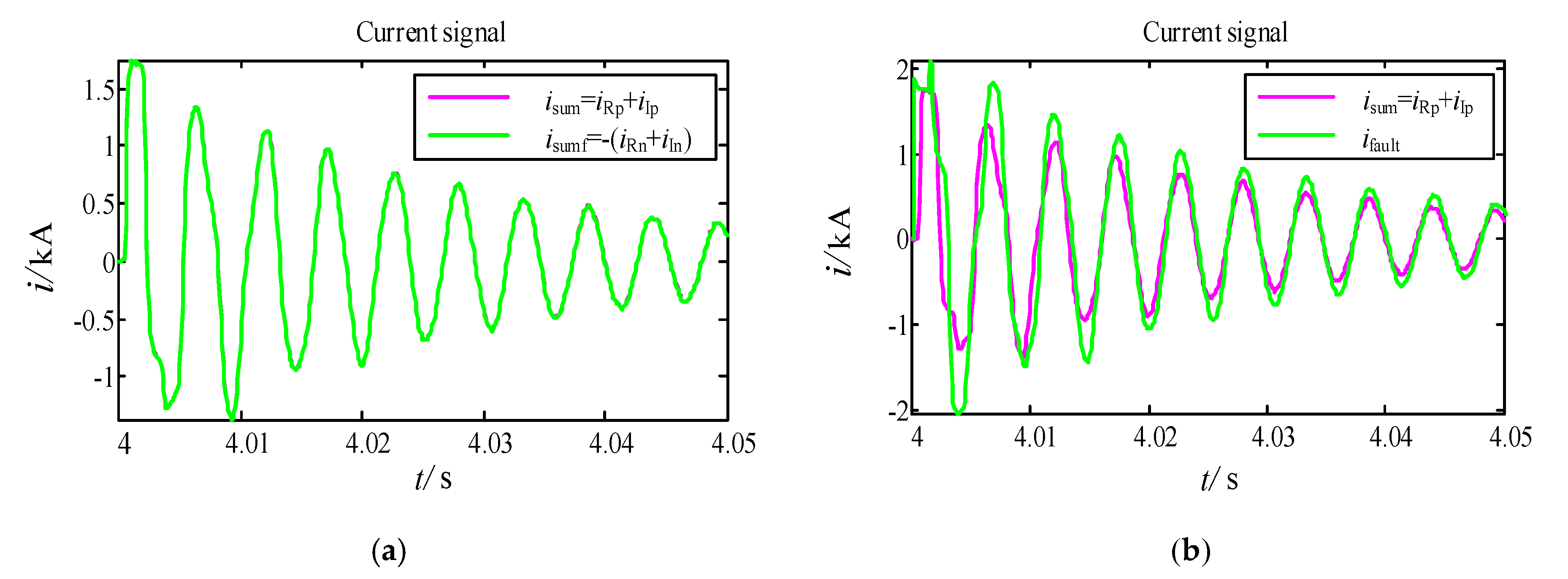
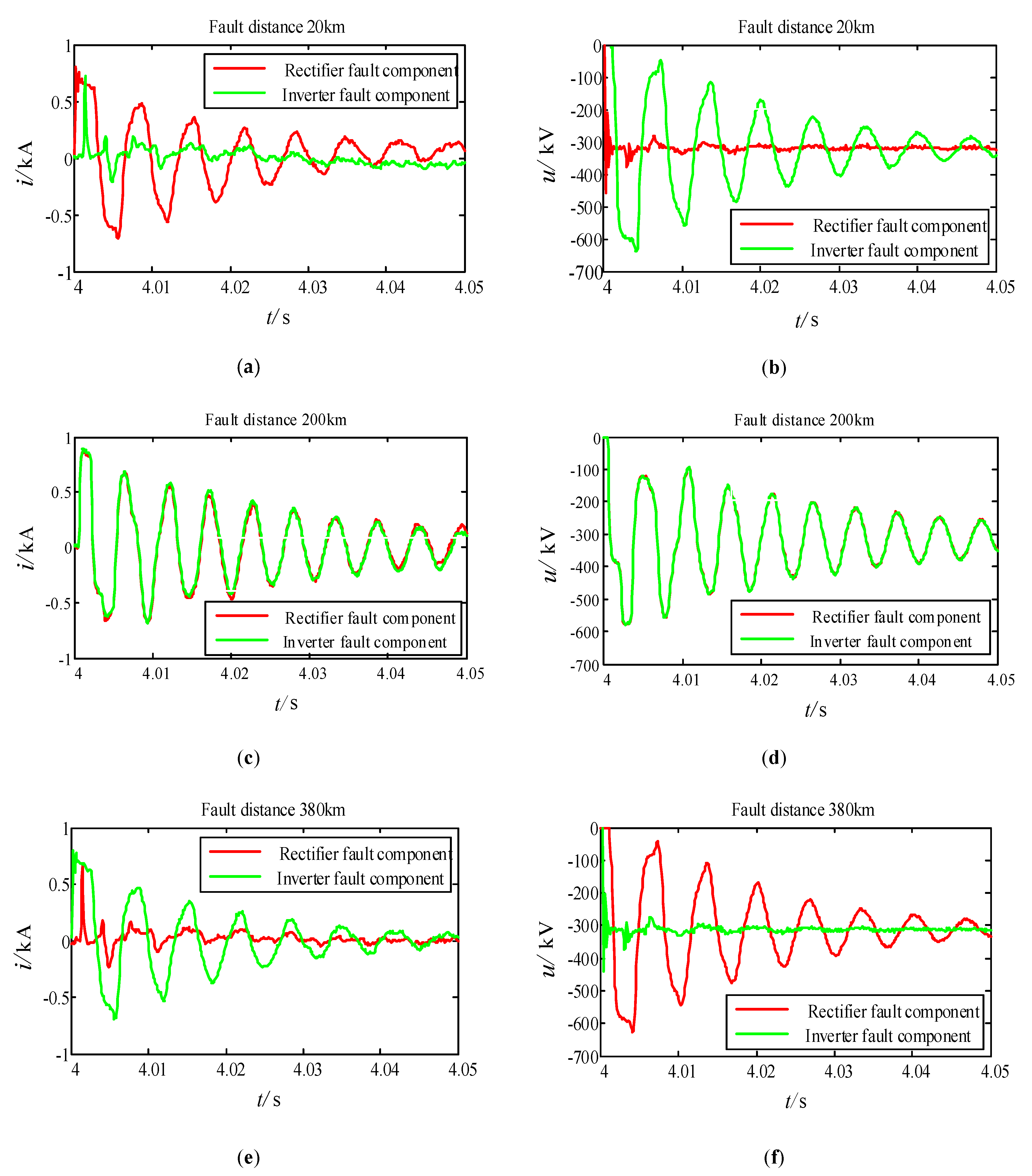


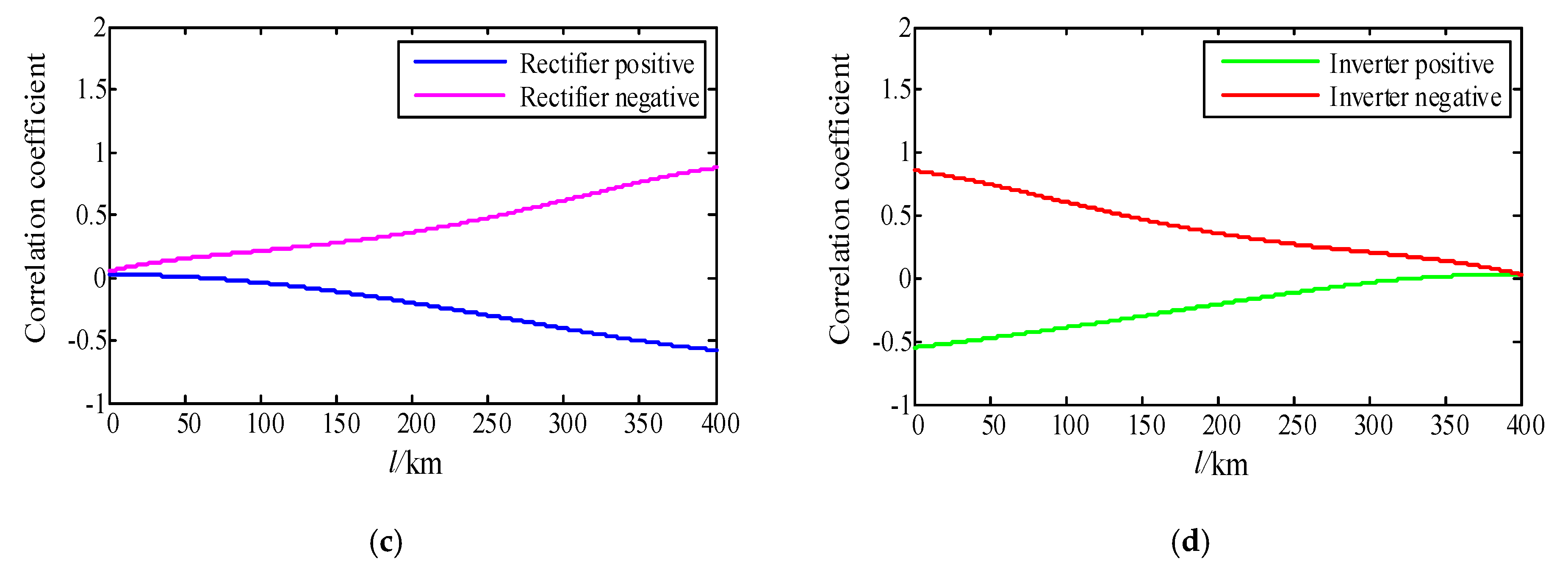
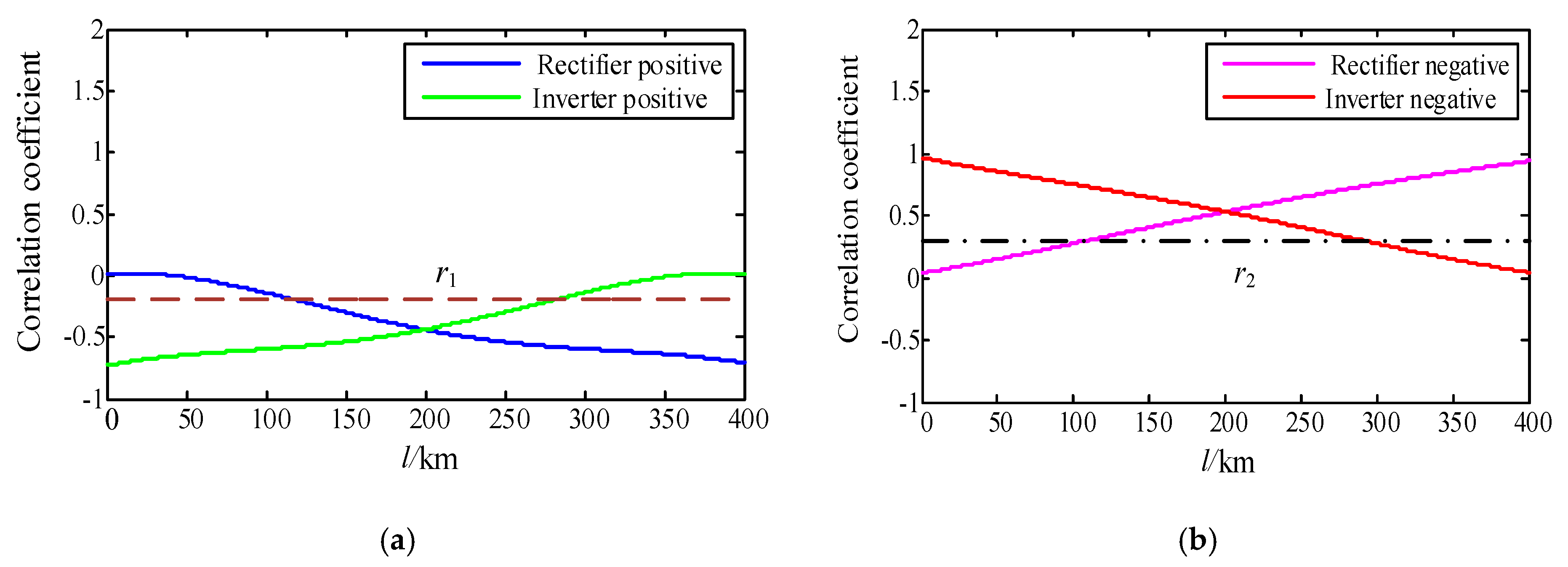
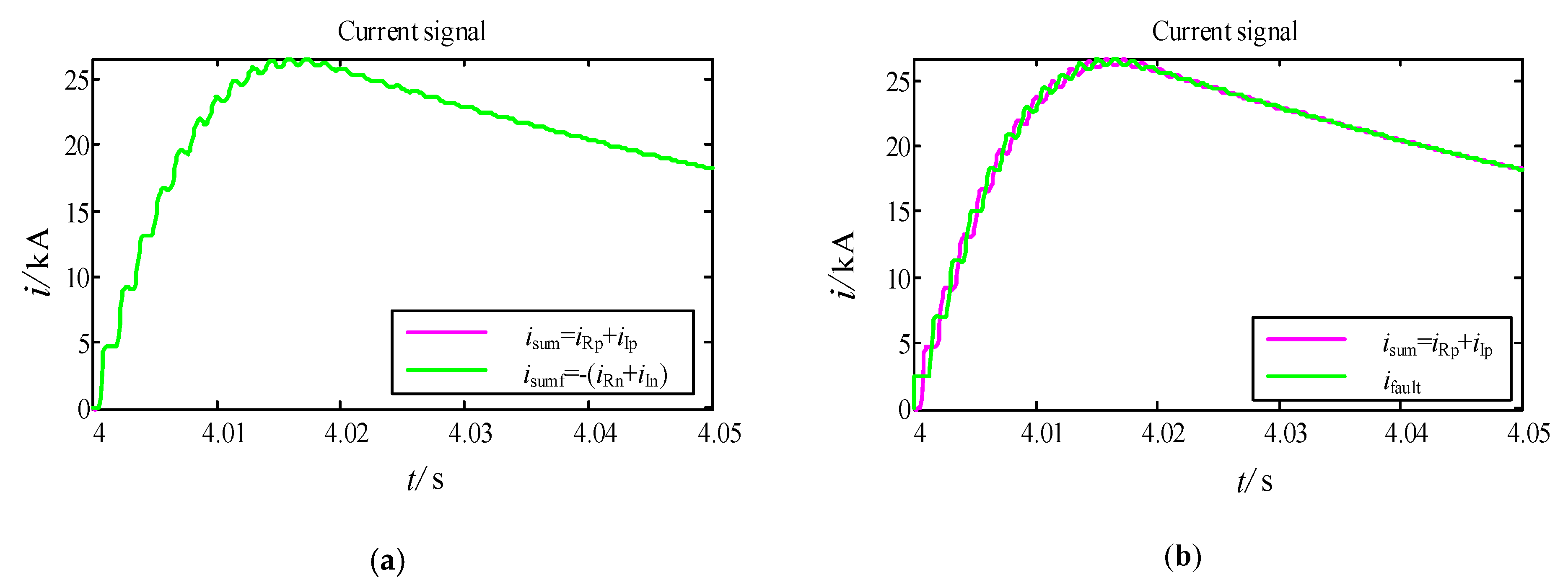




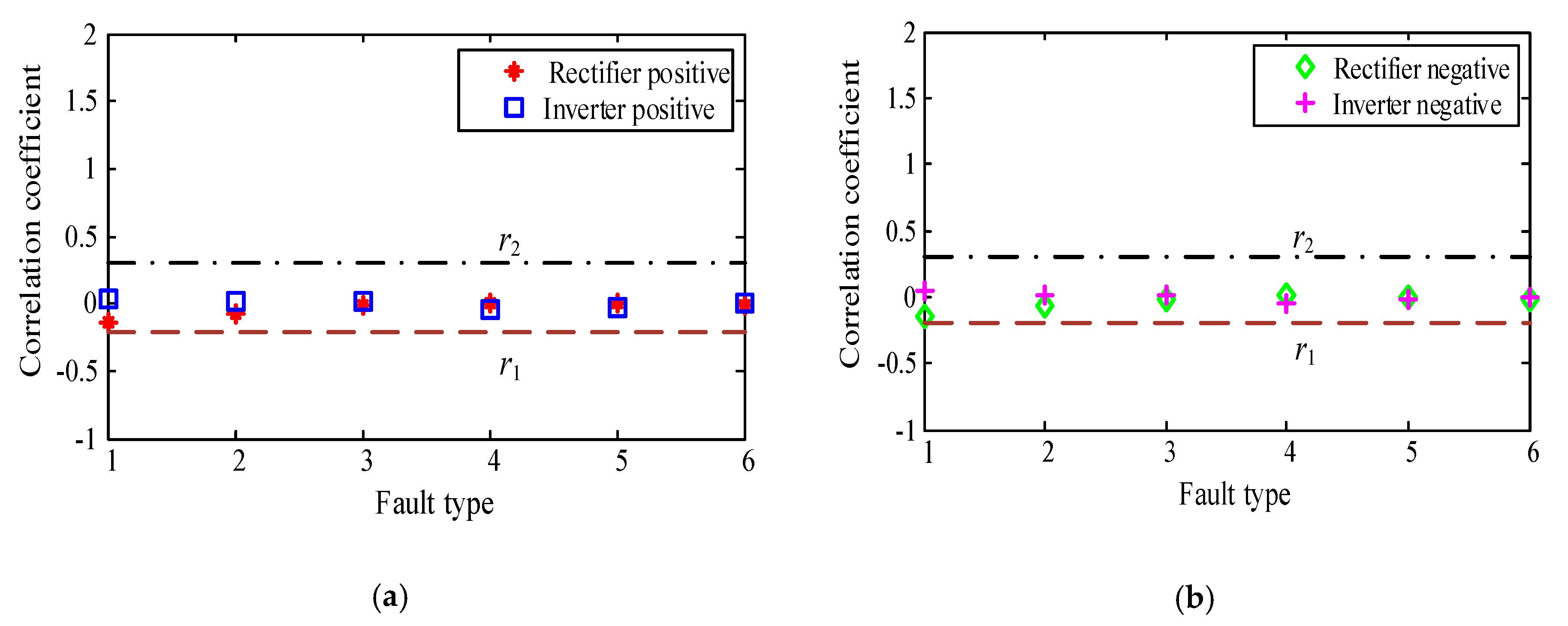



| Fault Types | Fault Distance (km) | Fault Resistance (Ω) | KR | KI | Min (KR, KI) < 0 | Result |
|---|---|---|---|---|---|---|
| f1 | 20 | 0.01 | 0.679 | −0.751 | Y | Single pole-to-ground fault |
| f1 | 60 | 0.01 | −0.168 | −0.744 | Y | Single pole-to-ground fault |
| f1 | 140 | 100 | −0.295 | −0.683 | Y | Single pole-to-ground fault |
| f1 | 180 | 0.01 | −0.735 | −0.858 | Y | Single pole-to-ground fault |
| f1 | 260 | 100 | −0.698 | −0.294 | Y | Single pole-to-ground fault |
| f1 | 320 | 0.01 | −0.799 | −0.461 | Y | Single pole-to-ground fault |
| f2 | 90 | 0.01 | −2.230 | −1.302 | Y | Single pole-to-ground fault |
| f2 | 190 | 0.01 | −1.201 | −1.159 | Y | Single pole-to-ground fault |
| f2 | 360 | 0.01 | −1.344 | −8.442 | Y | Single pole-to-ground fault |
| f3 | 100 | 100 | 1.000 | 1.000 | N | Other faults |
| f3 | 150 | 0.01 | 0.998 | 1.000 | N | Other faults |
| f3 | 300 | 0.01 | 1.000 | 1.000 | N | Other faults |
| f4 | -- | 0.01 | 0.999 | 1.000 | N | Other faults |
| f5 | -- | 0.01 | 1.006 | 1.000 | N | Other faults |
| Fault Types | Fault Distance (km) | Fault Resistance (Ω) | KR | KI | |KR| < 1, |KI| < 1 | |KR| > 1, |KI| > 1 | Result |
|---|---|---|---|---|---|---|---|
| f1 | 20 | 0.01 | 0.679 | −0.751 | Y | N | Positive pole-to-ground fault |
| f1 | 60 | 0.01 | −0.168 | −0.744 | Y | N | Positive pole-to-ground fault |
| f1 | 140 | 100 | −0.295 | −0.683 | Y | N | Positive pole-to-ground fault |
| f1 | 180 | 0.01 | −0.735 | −0.858 | Y | N | Positive pole-to-ground fault |
| f1 | 260 | 100 | −0.698 | −0.294 | Y | N | Positive pole-to-ground fault |
| f1 | 320 | 0.01 | −0.799 | −0.461 | Y | N | Positive pole-to-ground fault |
| f2 | 90 | 0.01 | −2.230 | −1.302 | N | Y | Negative pole-to-ground fault |
| f2 | 190 | 0.01 | −1.201 | −1.159 | N | Y | Negative pole-to-ground fault |
| f2 | 360 | 0.01 | −1.344 | −8.442 | N | Y | Negative pole-to-ground fault |
© 2020 by the authors. Licensee MDPI, Basel, Switzerland. This article is an open access article distributed under the terms and conditions of the Creative Commons Attribution (CC BY) license (http://creativecommons.org/licenses/by/4.0/).
Share and Cite
Shu, H.; An, N.; Yang, B.; Dai, Y.; Guo, Y. Single Pole-to-Ground Fault Analysis of MMC-HVDC Transmission Lines Based on Capacitive Fuzzy Identification Algorithm. Energies 2020, 13, 319. https://doi.org/10.3390/en13020319
Shu H, An N, Yang B, Dai Y, Guo Y. Single Pole-to-Ground Fault Analysis of MMC-HVDC Transmission Lines Based on Capacitive Fuzzy Identification Algorithm. Energies. 2020; 13(2):319. https://doi.org/10.3390/en13020319
Chicago/Turabian StyleShu, Hongchun, Na An, Bo Yang, Yue Dai, and Yu Guo. 2020. "Single Pole-to-Ground Fault Analysis of MMC-HVDC Transmission Lines Based on Capacitive Fuzzy Identification Algorithm" Energies 13, no. 2: 319. https://doi.org/10.3390/en13020319




